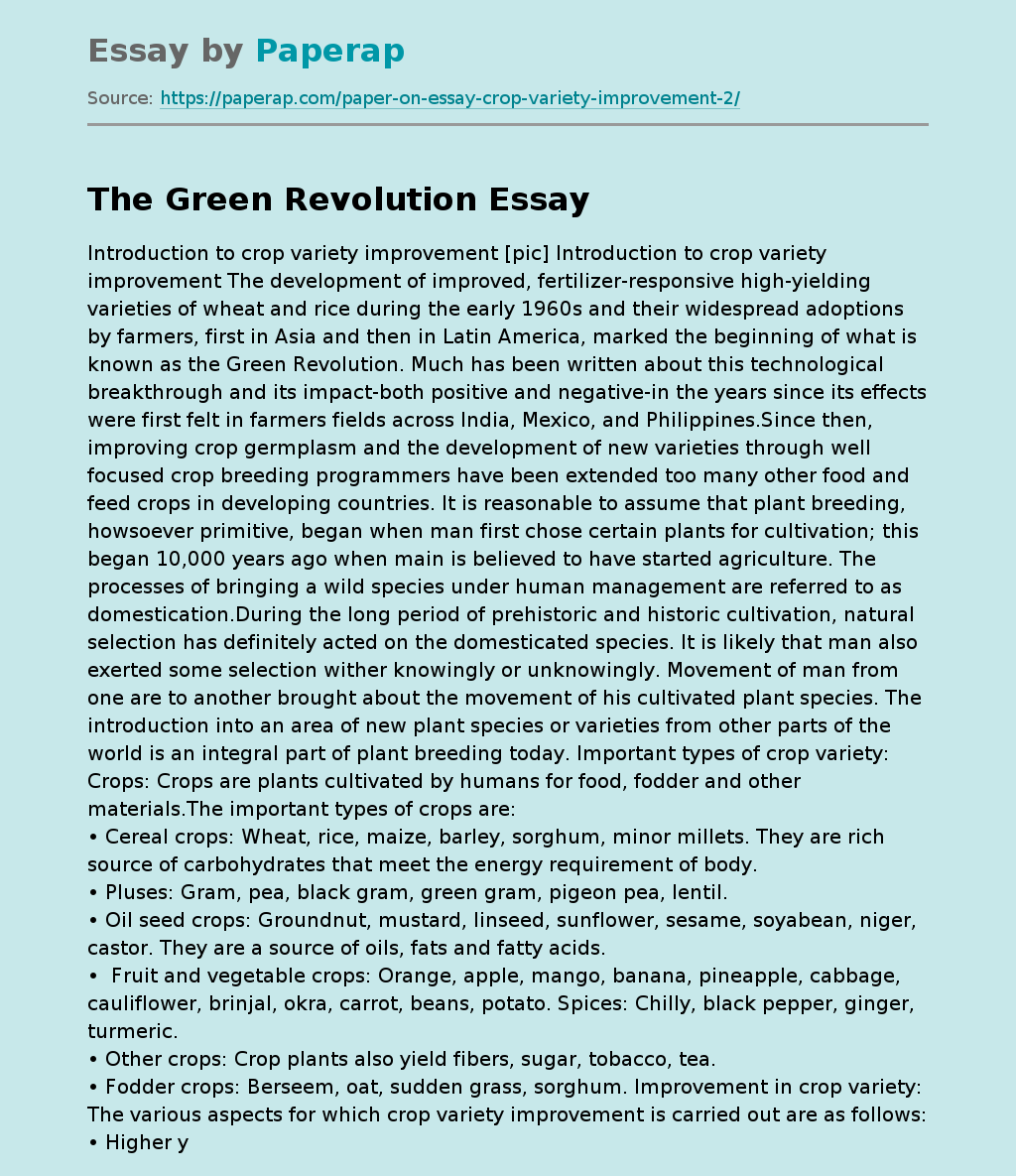Introduction to Crop Variety Improvement
The development of improved, fertilizer-responsive high-yielding varieties of wheat and rice during the early 1960s and their widespread adoptions by farmers, first in Asia and then in Latin America, marked the beginning of what is known as the Green Revolution. Much has been written about this technological breakthrough and its impact-both positive and negative-in the years since its effects were first felt in farmers fields across India, Mexico, and Philippines.Since then, improving crop germplasm and the development of new varieties through well focused crop breeding programmers have been extended too many other food and feed crops in developing countries.
It is reasonable to assume that plant breeding, howsoever primitive, began when man first chose certain plants for cultivation; this began 10,000 years ago when main is believed to have started agriculture. The processes of bringing a wild species under human management are referred to as domestication.During the long period of prehistoric and historic cultivation, natural selection has definitely acted on the domesticated species.
It is likely that man also exerted some selection wither knowingly or unknowingly. Movement of man from one are to another brought about the movement of his cultivated plant species. The introduction into an area of new plant species or varieties from other parts of the world is an integral part of plant breeding today. Important types of crop variety: Crops: Crops are plants cultivated by humans for food, fodder and other materials.The important types of crops are:
- Cereal crops: Wheat, rice, maize, barley, sorghum, minor millets.
They are rich source of carbohydrates that meet the energy requirement of body.
- Pluses: Gram, pea, black gram, green gram, pigeon pea, lentil.
- Oil seed crops: Groundnut, mustard, linseed, sunflower, sesame, soyabean, niger, castor. They are a source of oils, fats and fatty acids.
- Fruit and vegetable crops: Orange, apple, mango, banana, pineapple, cabbage, cauliflower, brinjal, okra, carrot, beans, potato. Spices: Chilly, black pepper, ginger, turmeric.
- Other crops: Crop plants also yield fibers, sugar, tobacco, tea.
- Fodder crops: Berseem, oat, sudden grass, sorghum. Improvement in crop variety: The various aspects for which crop variety improvement is carried out are as follows:
- Higher yield: The main aim of crop variety improvement is to obtain higher yield.
- Improved quality: The variety is improved to enhance the desirable quality, example: good baking in wheat, protein quality in pulses, more unsaturated oils in oil seeds, better taste of fruits. Biotic and Abiotic resistance: Crop yield is reduced due to the attack by microbes, insects, rodents and nematodes. It is also affected by various environment factors like foods, drought, water logging, frost and lodging.
- Change in maturity duration: the shorter the duration of crop, the more economical is the variety.
- Desirable agronomic traits: To achieve high productivity, the food crops should be dwarf. Crop Variety Improvement-plant Breeding Plant breeding is the branch of science concerned with changing the genotypes of plants so that they become more useful to human.
The objectives of plant breeding aims to improve the characteristics of plants so that they become more desirable agronomically and economically. Thus the chief objective of plant breeding is to develop such improved varieties of crop plants (crop variety improvement) that will be commercially successful. A successfully variety is one with a total balance of traits that makes it more profitable for growers than any other one they might choose. However, crop variety improvement in some traits of certain crops may become a priority objective for various agronomic, economic, etc. reasons. Therefore, specific objective would vary greatly depending on the crop under consideration. Objective of crop variety improvement
- To developing high yielding varieties• Improving the quality of crops
- To develop disease and insect resistance varieties
- Change in maturity duration of crops
- Modifying agronomic characteristics of crops such as plant height, tillering, branching etc. ,
- Photosensitivity: development of photoinsenisitve and thermosensitive crops
- Synchronous maturity
- Determinate growth Dormancy: removing dormancy
- Varieties for new seasons
- Moisture stress and salt tolerance: developing varieties for rainfed areas Activities in Crop Variety Improvement The desirable changes in genotypes of crop species and the consequents benefits to farmers are brought about by a series of interrelated and largely interdependent activities. The activities in crop variety improvement as follows
- Creation of variation
- Selection
- Evaluation
- Multiplication
- Distribution Crop variety improvement:
Breeding Methods in Crop PlantsSelf Pollinated Crops: Rice, Wheat, Barley, Sesame, Oats, Chickpea, Pea, Cowpea, Tomato Lentil, Green gram, Black gram, Soybean, Common bean, Moth bean, Linseed etc. , Cross Pollinated Crops: Maize, Pearl millet, Rye, Peaches , Carrot, Alfalfa, Coffee, Radish, Cabbage, Sunflower, Cherries, Sugar beet, Sugarcane, Cassava, Castor, Red clover, Cucumber, White clover, Safflower, Spinach, Onion, Garlic, Turnip, Squash, Muskmelon, Watermelon, , Pumpkin, Oil palm, Coconut, Papaya, Cocoa, Tea, Apple, Pears, grapes, Almond Strawberries, Pine apple, Banana, Cashew, Irish, Taro, Rubber, etc. ,
Introduction to Crop Variety Improvement. (2019, Dec 05). Retrieved from https://paperap.com/paper-on-essay-crop-variety-improvement-2/

